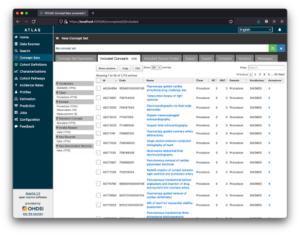FHIR Terminology Services for OMOP
Health Level Seven International (HL7®) and the Observational Health Data Sciences and Informatics (OHDSI) recently announced a collaboration to address the sharing and tracking of data in the healthcare and research industries across the FHIR and OMOP data models. The organizations will integrate HL7 Fast Healthcare Interoperability Resources (FHIR®) and OHDSI’s Observational Medical Outcomes Partnership (OMOP) common data model to achieve this goal.
One of the components of a harmonised data model, is a standard approach to managing, referencing and accessing the controlled vocabularies which underpin these data models. FHIR Terminology Resources provide a useful approach to managing Code Systems, Value Sets and Concept Maps and FHIR Terminology Operations such as Expand, Validate and Translate provide a standard approach to more readily use and interact with clinical terminologies.

OMOP Atlas is tool designed for use by researchers wishing to conduct exploratory data analysis over data structured using the OMOP Common Data Model (CDM). Atlas allows users to use a “concept set” to define a cohort definition. This can be greatly enhanced by using FHIR terminology services.
Scientists at the CSIRO Australian e-Health Research Centre have undertaken a scoping study to identify the opportunities that exist to enable FHIR-based terminology services to better support OMOP users.
The objectives of the project were to:
- Understand how both the OMOP model and tooling supports the use of standard terminologies;
- Explore how FHIR Terminology Services can be used within the OMOP tooling – including prototype integration;
- Identify opportunities within BDHP partners that can use the Qld Clinical Terminology Service to support OMOP related projects; and
- Identify and scope opportunities for Australian uses of the AHRA Terminology service to support OMOP related projects.
The report identified a number of opportunities for strategic enhancements to tool implementations. These show promise for providing significant benefit to OMOP users with a need to integrate with FHIR data and FHIR terminology services. This work would also have wider benefits for improving the alignment of these complementary standards, and improving the quality of terminology within health data analytics more generally.
As part of this work, the team has forged links with key members of both the HL7 FHIR and OHDSI Vocabulary communities. It has also been a particularly well-timed exercise since OHSDI has now split out the OMOP Vocab Working Group as a separate entity to the OMOP Common Data Model Working Group with a specific “FHIR Terminology Alignment” agenda.
It is recommended that further evaluation of these proposals be conducted in parallel to the ongoing work that is going on to harmonise and align OMOP and FHIR at the standards level with strong engagement with this Working Group.
The full report is available to download here.
The Australian e-Health Research Centre (AEHRC) is CSIRO's digital health research program and a joint venture between CSIRO and the Queensland Government. The AEHRC works with state and federal health agencies, clinical research groups and health businesses around Australia.
